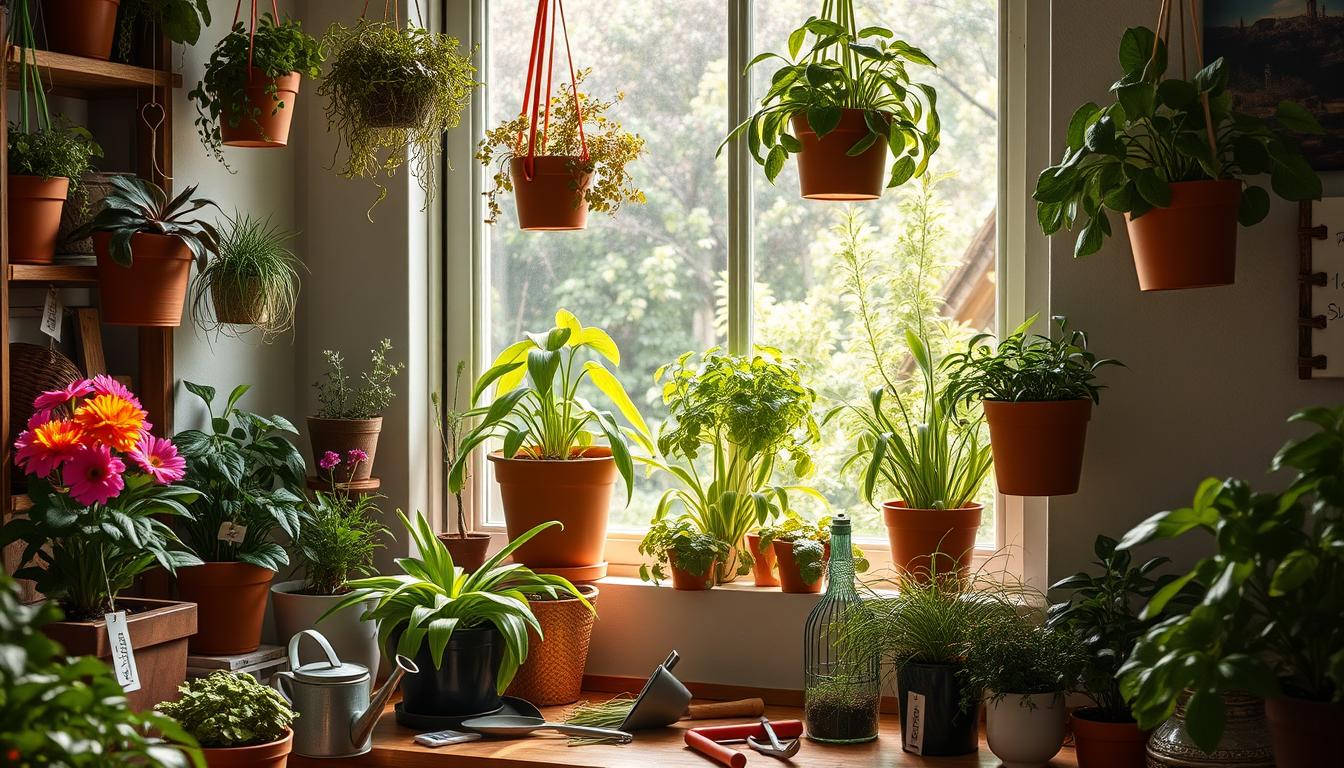Welcome to my guide on indoor gardening. I’m excited to share my love for growing plants indoors. It’s a great way to add some nature to your home and clean the air.
I’ll share my knowledge with you, from picking the right plants to creating the perfect environment. Whether you’re new to gardening or have experience, you’ll find helpful tips here.
In this article, we’ll dive into the world of indoor gardening. I’ll give you the tips you need to start growing your own plants indoors. From the basics to advanced techniques, I’ve got you covered.
Why I Love Indoor Gardening
I fell in love with indoor gardening because of its many benefits. House plants not only purify the air and make my home look better. They also bring a sense of calm and well-being.
Indoor gardening is a great way to bring nature inside. It helps create a peaceful atmosphere in my home.
Some key benefits of indoor gardening include air purification, stress reduction, and better mental health. By following indoor gardening tips, I’ve made my indoor garden thrive. It beautifies my space and boosts my well-being. Here are a few reasons why I enjoy indoor gardening:
- Low maintenance: House plants are easy to care for, making them perfect for busy people.
- Aesthetically pleasing: Indoor plants add natural beauty to any room, making it welcoming.
- Air purification: Some house plants purify the air, improving indoor air quality and promoting healthier living.
As I continue to explore indoor gardening, I’m excited to share my experiences and tips. Whether you’re a seasoned gardener or just starting, indoor gardening is a great way to connect with nature. It helps create a peaceful oasis in your home. 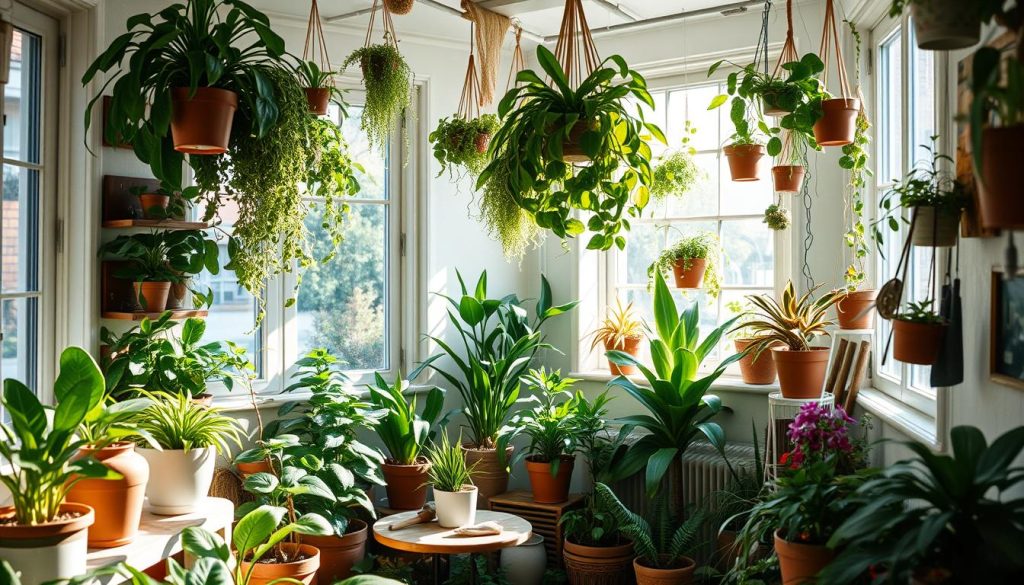
Choosing the Right Plants for My Space
Choosing the right plants for indoor gardening is key. With many options, picking the right ones can be tough. I start by checking the light in my home. This tells me which plants will get enough light, whether it’s natural or from grow lights.
Grow lights are often used in indoor gardening. They help plants grow by providing the right light. I pick plants based on how much light they need. For example, plants like Chinese Evergreen or Pothos do well in low light. But plants like Basil or Mint need more sunlight.
Assessing Light Conditions
I look at my home’s light by checking the windows and the time of day. I see how much shade or sunlight each area gets. This helps me pick the best plants for each spot and make sure they get enough light.
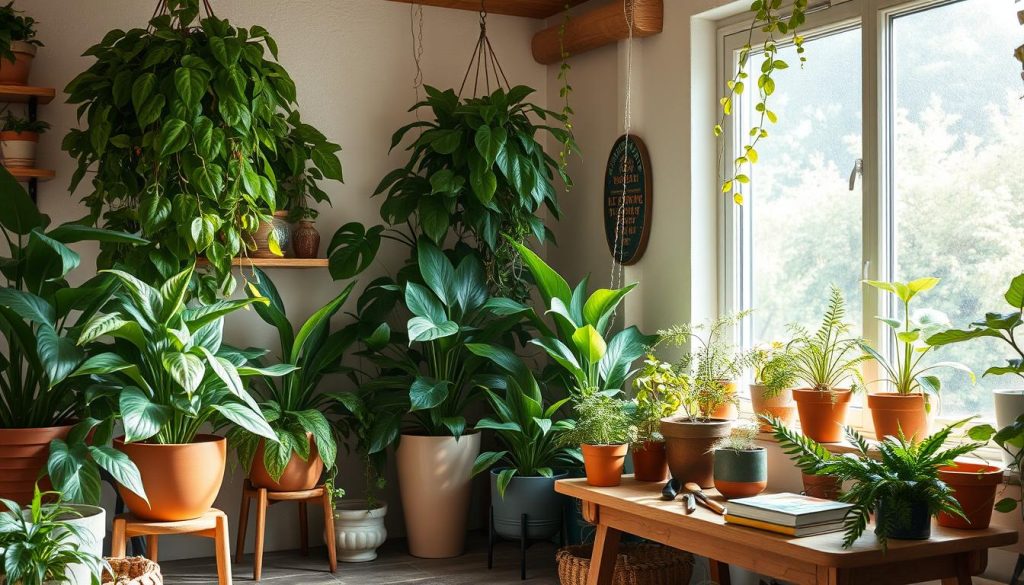
Low-Light Plant Options
In low-light areas, I choose plants that do well without much light. Favorites include Snake Plant, Spider Plant, and Peace Lily. These plants are not only pretty but also clean the air and make my space feel calm.
Setting Up a Plant Care Schedule
After picking the right plants, I make a care schedule. It covers watering, fertilizing, and pruning. I also watch the temperature and humidity. Keeping to this schedule helps my plants stay healthy and lets me enjoy the benefits of indoor gardening.
Essential Tools for Indoor Gardening
As I explore indoor gardening, I’ve learned the value of the right tools and supplies. Good plant care is key for my plants’ health and growth. The right indoor gardening supplies make a big difference.
I’ve bought some essential gardening tools. These include a watering can, pruning shears, and a soil test kit. They help me care for my plants effectively.
Must-Have Gardening Tools
- Watering can
- Pruning shears
- Soil test kit
Importance of Quality Soil
Quality soil is vital for indoor gardening. It gives my plants the nutrients they need to grow. I choose a potting mix that drains well and is made for indoor plants.
Using the Right Fertilizers
Fertilizers are good for my plants, but I use them carefully. I prefer a balanced, water-soluble fertilizer made for indoor plants.
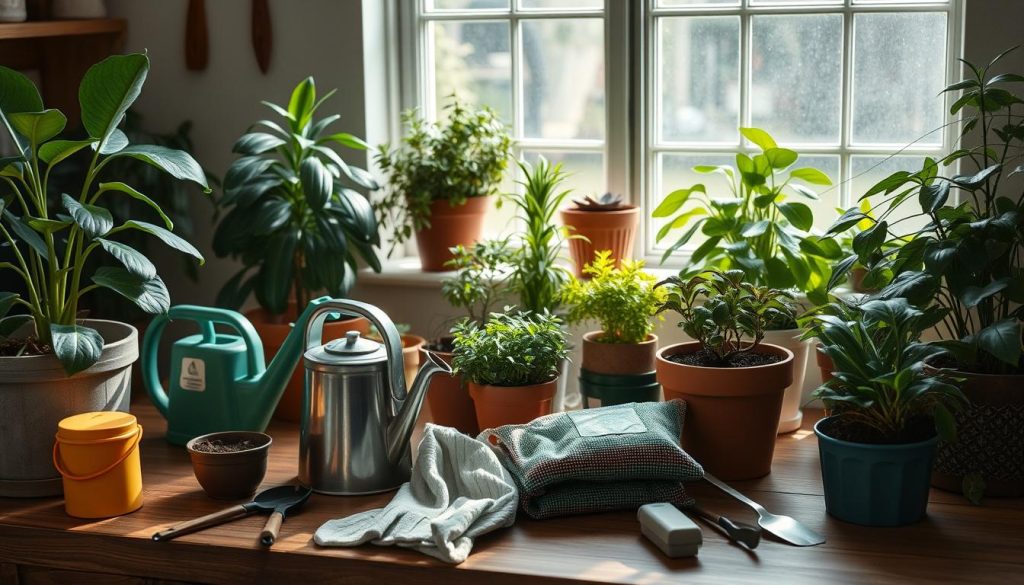
With the right tools and supplies, I can give my plants the care they need. Through practice and patience, I’ve grown more confident in caring for my plants and using the right supplies.
| Tool | Description |
|---|---|
| Watering can | Used for watering plants |
| Pruning shears | Used for pruning and trimming plants |
| Soil test kit | Used for testing soil pH and nutrient levels |
Creating an Ideal Indoor Environment
To grow the best indoor plants, you need to create a perfect indoor space. This means thinking about temperature, humidity, and air flow. By getting these right, your plants will thrive, and you’ll enjoy the benefits of indoor gardening.
Temperature is key in indoor gardening. Most plants like daytime temperatures between 65-75°F (18-24°C). At night, they prefer it 5-10°F (3-6°C) cooler. Humidity matters too, with most plants liking a relative humidity of 40-60%. To keep humidity right, you can use a humidifier or group plants together.
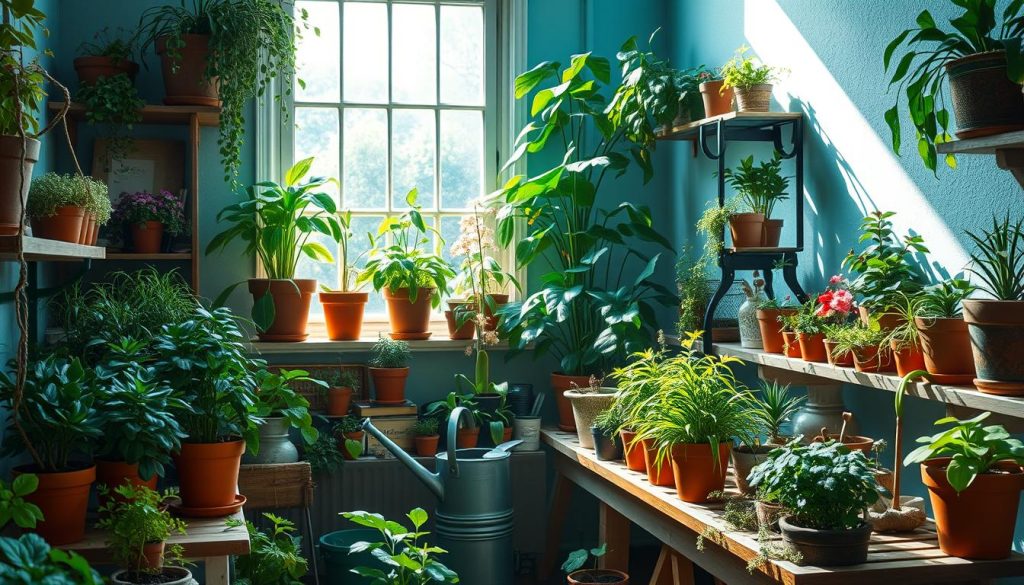
Temperature Considerations
- Keep plants away from heating vents and radiators
- Use a thermometer to monitor temperature
- Avoid placing plants near drafty windows or doors
Humidity Levels and Control
To control humidity, use a humidifier or dehumidifier. Some plants, like ferns and peace lilies, need more moisture. Others, like cacti and succulents, prefer it drier.
Air Circulation Tips
Good air flow is vital for healthy plants. Make sure plants have enough space and use fans to move the air. This helps prevent diseases and promotes growth.
Watering Techniques That Work for Me
Watering is key in indoor gardening. The right amount of water is crucial for my house plants’ health. I’ve found a few techniques that work well for me.
Every plant is different. Some need more water, while others prefer to dry out a bit. I check the soil by sticking my finger in it. If it’s dry, it’s time to water.
Signs of Overwatering
Overwatering can harm indoor plants. Look out for yellow leaves, droopy stems, and soggy soil. Regularly checking the soil helps me avoid this mistake.
Best Practices for Effective Watering
To water my plants right, I follow some best practices. I water in the morning, so they can absorb it all day. I use water that’s room temperature to avoid shocking the roots. And I avoid getting water on the leaves to prevent diseases.
By using these techniques, my indoor plants stay happy and healthy. Watering is an art that needs patience and observation. It’s about adjusting to what your plants need.
- Check soil moisture regularly
- Water plants in the morning
- Use room-temperature water
- Avoid getting water on the leaves
With these tips, you’ll become a skilled indoor gardener. You’ll know how to water your plants just right.
Container Choices for Every Plant
Choosing the right container for your plants is key for their health. With many options, picking the best one can be tough. I suggest looking at the container’s size, material, and drainage.
Types of Containers to Consider
There are many types of containers, like plastic, ceramic, and wooden ones. Each has its own good and bad points. For instance, plastic is cheap and light but not as pretty as ceramic or wood.
I like to mix different containers to make my space look interesting. This adds a unique touch to my indoor garden.
Drainage Solutions
Good drainage is vital for plants to grow well. I use a few methods to make sure my containers drain well. I add small rocks or broken pottery at the bottom and use a potting mix that drains well.
By doing this, I prevent waterlogged soil and root rot. These tips help keep my plants healthy.
Customizing Containers for Aesthetics
To make your indoor garden special, think about customizing your containers. You can paint or decorate them to fit your home’s style. Or, add a decorative saucer or tray to catch water.
By using these ideas, you can make a beautiful and thriving indoor garden. It will show off your personal style.
Pest Control for Indoor Plants
As I care for my indoor garden, I’ve learned pest control is key. Indoor plants face many pests that harm their health and look. Using grow lights and pest control is vital for their well-being.
Common pests include spider mites, mealybugs, and aphids. Natural methods like neem oil or insecticidal soap can fight these pests. These methods help keep my plants safe.
It’s important to watch your plants for pests. Look for white patches, sticky leaves, or actual pests. Early detection stops pests from harming your plants. Sometimes, chemical treatments are needed. But I choose natural methods to keep my garden healthy.
Common Pest Control Methods
- Neem oil: a natural insecticide that can be used to control a wide range of pests
- Insecticidal soap: a mild and non-toxic pesticide that can be used to control soft-bodied pests
- Sticky traps: a non-toxic way to capture and remove flying pests
Using these methods and proper care, including grow lights, keeps your plants healthy. This way, they can thrive indoors.
Propagation Techniques I’ve Learned
Propagation is a fantastic way to share plants with loved ones or grow new ones for your garden. The right tools make a big difference. Choosing the best plants for propagation is crucial for success.
Methods for Propagating Common Plants
There are many ways to propagate plants, like stem and leaf cuttings, and division. Each method needs specific tools and supplies. You’ll need a sharp knife, a pot, and soil that drains well.
Tools and Supplies Needed
To start propagating, you’ll need some basic items. These include:
- A sharp knife or pruning tool
- A pot or container with good drainage
- A well-draining soil mix
- Water and a watering can
Success Stories from My Propagation Attempts
I’ve successfully propagated many plants, like succulents and herbs. With the right supplies and techniques, you can too. Enjoy the rewards of growing your own plants.
Seasonal Care for Indoor Plants
As someone who loves indoor gardening, I know how key it is to adjust care with the seasons. Indoor plants need special care at different times of the year to grow well. Here, I’ll share my tips for caring for your plants in winter, spring, and summer.
Indoor gardening comes with its own set of challenges for each season. For instance, plants need less water and more humidity in winter. Spring and summer, with their longer days and warmer weather, mean more growth and water.
Adapting Care in Winter
In winter, I water my plants less and add more humidity. This keeps them from drying out and helps them grow. I also make sure they get enough light, as the short days can make photosynthesis harder.
Spring Care Routines
In spring, I go back to my usual watering and start fertilizing more often. This boosts growth and color. I also prune and repot my plants, giving them a fresh start.
Preparing for Summer Heat
As summer comes, I protect my plants from the heat. I move them away from direct sun and use curtains to soften the light. I also water them more often, but carefully to avoid harming them.
Some key tips for seasonal care of indoor plants include:
- Monitoring temperature and humidity levels
- Adjusting watering schedules according to the season
- Providing sufficient light and fertilization
- Pruning and repotting plants as needed
Decorating My Space with Indoor Plants
Indoor plants bring natural beauty to my home. They purify the air and offer health benefits. Plus, they add a touch of elegance to my decor.
When picking plants, I think about the look I want. I choose plants that match my style.
Creative Placement Ideas
I love finding unique spots for my plants. They look great on bookshelves, in room corners, or hanging from the ceiling. This creativity adds interest and makes my space special.
Combining Plants with Home Decor
I mix my plants with other decor to create a unified look. I pair plants with pots or vases that match their colors. Or, I group them with other items.
This way, my home becomes a beautiful, welcoming space. It shows off my personal style and gardening skills.
Sustainable Indoor Gardening Practices
Exploring indoor gardening, I’ve learned about sustainable practices. Using eco-friendly products is key. I seek out products that are good for the planet and our plants.
I recommend natural fertilizers, recycled pots, and energy-saving grow lights. These items cut down on waste and help plants grow well. For instance, grow lights can lower the need for outdoor lights, saving energy.
Eco-Friendly Products and Recycling
Recycling is also vital in sustainable gardening. It lessens waste and saves resources. Recycling in gardening means reusing pots, composting, and using rainwater.
Reducing Waste in the Garden
To cut down on waste, I use a few simple strategies:
- Choose reusable pots and planters
- Compost plant waste
- Opt for energy-efficient grow lights
These steps help me reduce my environmental footprint. With some creativity, anyone can make a sustainable indoor garden. It’s a space that’s good for the planet and a joy to relax in.
Joining Indoor Gardening Communities
Connecting with others who love indoor gardening can change your journey. Join online groups and local clubs to share, learn, and grow. You’ll take your plant care to new levels.
Finding Online Support Groups
Online places like Reddit’s r/IndoorGarden or Facebook groups are full of knowledge. You can ask questions, get advice, and find inspiration. It’s a great way to learn more about indoor gardening.
Local Gardening Clubs to Explore
Look for gardening clubs or societies near you. They often have workshops, plant swaps, and events. These are great places to meet others and learn new things.
Sharing My Experiences and Learning from Others
Don’t hesitate to share your stories and lessons. Being part of the indoor gardening community helps everyone. We can all learn and grow together.

